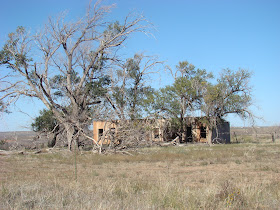This old stretch of Route 66 has got it all. It is the original gravel road. It has ghost towns. It follows a fallen flag railroad, the Rock Island, and it has wild life. Did I mention an upside-down tree and longhorns?
"Glenrio is located in extreme northwest Deaf Smith County, Texasand along the eastern border of Quay County, New Mexico.
To get to Glenrio, while traveling west along I-40, you will take exit 369 off of I-40 (Endee exit), turn right at the stop, and left onto the north frontage road.
When traveling eastbound on I-40, you can take the Bard Exit 361. Note that the majority of the road from Bard to Glenrio is dirt and gravel." Source of text:http://www.legendsofamerica.com/tx-glenrio2.html
"Straddling the border between Texas and New Mexico is the forgotten ghost town of Glenrio. Once a monument along the boom and bust highway of Route 66, it now remains home to only the critters and the blowing tumble weeds of the vast prairie."
"In 1901 the Chicago, Rock Island and Pacific Railroad came through the area and two years later Glenrio was born. The name Glenrio, which stems from the English word "valley” and the Spanish word for river, is neither in a valley nor along a river."
"A post office was established on the New Mexico side of the community, but the mail arrived at the railroad depot located on the Texas side. Sitting in its precarious location crossing Texasand New Mexico, Glenrio became the subject of a long battle between both states for tax rights."
The last Motel in Texas and the First Motel in New Mexico, unless you are coming from the other way. Texas is on the right side of gas station/office door and New Mexico is on the left side.
"By 1920 Glenrio had a hotel, a hardware store, and a land office, as well as several grocery stores, service stations, and cafes. A newspaper, the Glenrio Tribune, was published from 1910 to 1934. There were no bars on the Texas side of the community, since Deaf Smith County was dry, and no service stations on the New Mexico side because of that state's higher gasoline tax."
Longhorns are occupying the Railroad grade of the old Rock Island Line that runs parallel to Route 66 along this stretch.
They provide a dis-incentive to hunt for R.R. relics along the right of way.
"In 1905 the region was opened to small farmers, who settled on choice 150-acre plots and a year later the Chicago, Rock Island and Gulf Railway established a station at Glenrio. The settlement began to bustle with cattle and freight shipments. Initially the area was primarily populated by large cattle ranches but as time passed much of the surrounding land was planted in wheat and sorghum and the farming expansion was responsible for most of the growth of the area population."
"Five miles past Glenrio is the ghost town of Endee, New Mexicowhich had a population of 110 in 1946. Along the way you can view several abandoned homes and structures before arriving at Endee."
This old Endee Motor Court sits south of I-40 on original Route 66, now a dirt Road.

"Continuing west on old Route 66, the dirt and gravel road will take you all the way to San Jon, if road conditions permit."























Rock Island RR had a song in it's glory days. The large convuluted rail system has been divied up,
ReplyDeletetore up and the best of the old
Rock Island routes, Chicago to
Omaha is still running fast freights under the Iowa Interstate
Railroad. IAIS has gone so far as to paint a 'heritage' locomotive
in honor of the historic railroad.
Gosh durn, here is a photo of
ReplyDeletethe heritage locomotive ...